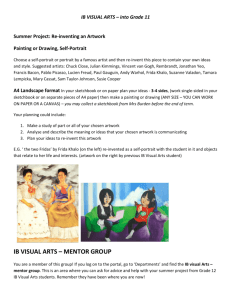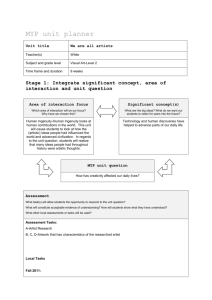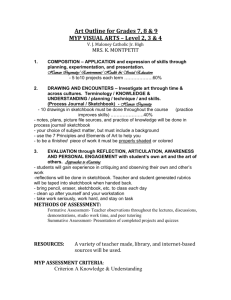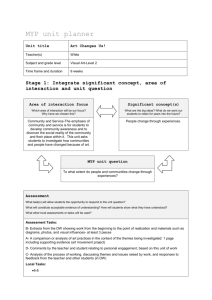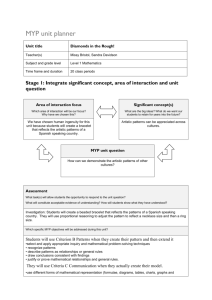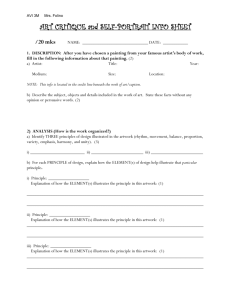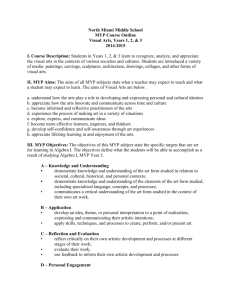MYP unit planner
advertisement
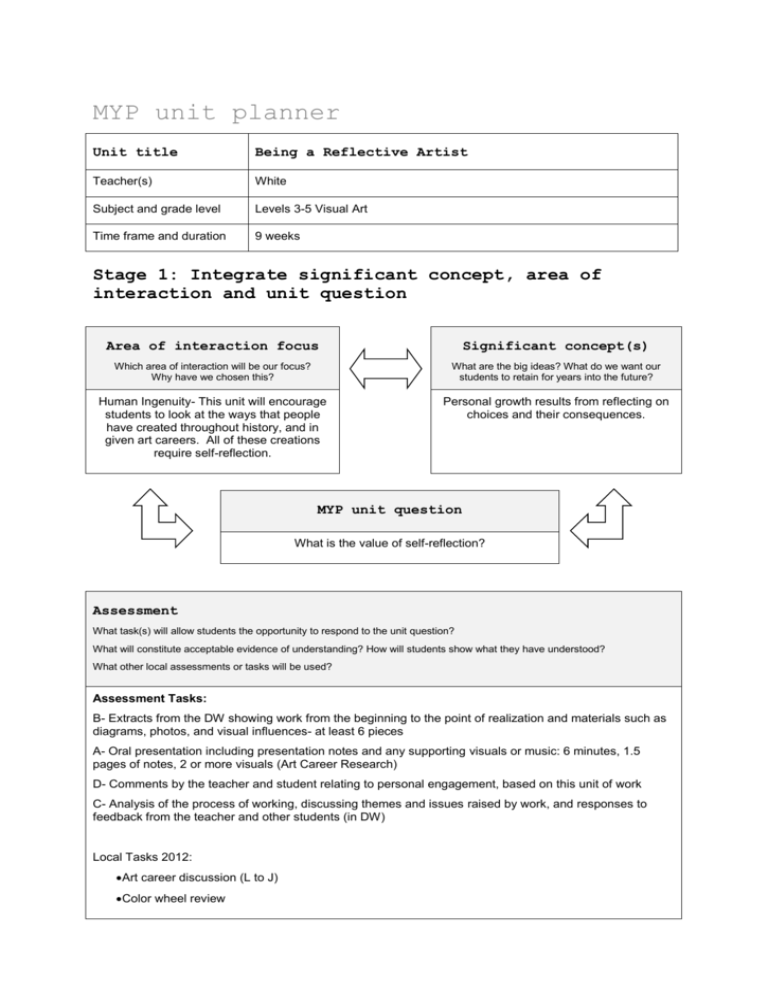
MYP unit planner Unit title Being a Reflective Artist Teacher(s) White Subject and grade level Levels 3-5 Visual Art Time frame and duration 9 weeks Stage 1: Integrate significant concept, area of interaction and unit question Area of interaction focus Significant concept(s) Which area of interaction will be our focus? Why have we chosen this? What are the big ideas? What do we want our students to retain for years into the future? Human Ingenuity- This unit will encourage students to look at the ways that people have created throughout history, and in given art careers. All of these creations require self-reflection. Personal growth results from reflecting on choices and their consequences. MYP unit question What is the value of self-reflection? Assessment What task(s) will allow students the opportunity to respond to the unit question? What will constitute acceptable evidence of understanding? How will students show what they have understood? What other local assessments or tasks will be used? Assessment Tasks: B- Extracts from the DW showing work from the beginning to the point of realization and materials such as diagrams, photos, and visual influences- at least 6 pieces A- Oral presentation including presentation notes and any supporting visuals or music: 6 minutes, 1.5 pages of notes, 2 or more visuals (Art Career Research) D- Comments by the teacher and student relating to personal engagement, based on this unit of work C- Analysis of the process of working, discussing themes and issues raised by work, and responses to feedback from the teacher and other students (in DW) Local Tasks 2012: Art career discussion (L to J) Color wheel review Painting challenges Painting that communicates something (must have a color scheme) 1, 2 and 3-point perspective drawings (pencil) Research on different types of perspective Create a work of art using one type of perspective Collaborative print-making assignment Self-portrait Art nouveau Local Tasks 2011: Warm-ups weeks 1-6 Sketchbook #’s 1-3 Paper-making Artwork that communicates something Self-portrait Seminar-Guernica (correlates with Level 5 study on the Spanish civil war) Which specific MYP objectives will be addressed during this unit? B-Develop an idea, theme or personal interpretation to a point of realization, expressing their artistic intentions Apply skills, techniques, and processes to create, perform and/or present art A-Demonstrate knowledge and understanding of the art form studied in relation to societal, cultural historical and personal contexts Demonstrate knowledge and understanding of the elements of the art form studied, including specialized language, concepts and processes Communicate a critical understanding of the art form studied in the context of their own artwork D-Show commitment in using their own artistic processes Demonstrate curiosity, self-motivation, initiative and a willingness to take informed risks Support, encourage and work with their peers in a positive way Be receptive to art practices and artworks from various cultures, including their own C-Reflect critically on their own artistic development and processes at different stages of their work Evaluate their work Use feedback to inform their own artistic development and processes Which MYP assessment criteria will be used? Criterion A,B,C and D Stage 2: Backward planning: from the assessment to the learning activities through inquiry Content What International Connections are being made throughout this unit? What knowledge and/or skills (from the course overview) are going to be used to enable the student to respond to the unit question? What (if any) state, provincial, district, or local standards/skills are to be addressed? How can they be unpacked to develop the significant concept(s) for stage 1? International Connections: Students will make an international connection through sketchbook assignments. Every week, students will also explain (through writing) how their sketchbook assignment shows something about another culture or country. Students will see the work of and discuss aspects of the work of art via warm-ups Students will look at artist styles from around the world (perspective) 8.CX.1.1 8.CX.1.3 8.CX.2.1 8.CX.2.2 8.CR.1.2 8.V.1.2 8.V.2.2 8.V.2.3 8.V.3.1 8.V.3.2 8.V.3.3 Approaches to learning How will this unit contribute to the overall development of subject-specific and general approaches to learning skills? Students will collaborate with classmates and within their table group setting. Learning experiences How will students know what is expected of them? Will they see examples, rubrics, templates? How will students acquire the knowledge and practise the skills required? How will they practise applying these? Do the students have enough prior knowledge? How will we know? Students will see examples, non-examples, checklists and rubrics for tasks. Students will acquire the knowledge based on demonstrations and hands-on experiences. Prior student knowledge will be assessed with warm-up questions. Further formative assessments will be conducted verbally and through observation, and will continue for the duration of the unit as new skills and concepts are introduced. Teaching strategies How will we use formative assessment to give students feedback during the unit? What different teaching methodologies will we employ? How are we differentiating teaching and learning for all? How have we made provision for those learning in a language other than their mother tongue? How have we considered those with special educational needs? Verbal and demonstrative formative assessments will be used to give students feedback during the unit. The teacher will give group and one-on-one demonstrations and will discuss how given examples are examples or non-examples of the desired product. The teacher will employ various teaching strategies, including: demonstrations, discussions, collaborative work and peer feedback in a group setting, and through a culminating chance for students to present products to the class. Instruction will be differentiated as needed during every class period. Further examples, demonstrations, and reminders will be given to individual students and to the class. With these additional supports in place, all students will learn the concepts of the unit. For those learning in a language other than their mother tongue, handouts will be given in the appropriate language. Students with special educational needs will receive differentiated instructions for tasks and additional scaffolding as needed. Resources What resources are available to us? How will our classroom environment, local environment and/or the community be used to facilitate students’ experiences during the unit? NC Standard Course of Study The internet for art examples www.gaggle.net Computers with word processing and internet access The knowledge, expertise and experiences of others in the classroom Ongoing reflections and evaluation In keeping an ongoing record, consider the following questions. There are further stimulus questions at the end of the “Planning for teaching and learning” section of MYP: From principles into practice. Students and teachers What did we find compelling? Were our disciplinary knowledge/skills challenged in any way? Students were challenged to create a self-portrait. Students used the grid technique and rose to the challenge. The process resulted in quality products and students seemed to be proud of their work, for the most part. What inquiries arose during the learning? What, if any, extension activities arose? Inquiries-“Do we have to use the grid technique?” Students chose the method they thought was the most useful. For most students who did NOT use the grid technique, they did much erasing and wished they had let the grid help them. How did we reflect—both on the unit and on our own learning? Plus/Delta/Next Steps every other week or every 3rd week Students completed self-assessments at the end of every assignment Students reflected during warmup questions and exit questions Which attributes of the learner profile were encouraged through this unit? What opportunities were there for student-initiated action? Students were intentionally encouraged to be risk-takers through participating in the paper-making project. It was stressed that sometimes what is important is the product, and sometimes the process and taking risks is more beneficial. Students used this sense of risk-taking when they went on to complete a large self-portrait. Students collaborated with a partner when they made paper. Students reflected frequently throughout the unit, on both their own work and the work of others Students were open-minded in accepting others’ self-portraits as a unique expression of themselves. Possible connections How successful was the collaboration with other teachers within my subject group and from other subject groups? 2011 I asked teachers in my school what images were relevant to their current area of study. Based on feedback, I used Pablo Picasso’s “Guernica” as an image for a seminar. Students gained some background knowledge of the painting before discussing it in AP World History with Mr. Reid. What interdisciplinary understandings were or could be forged through collaboration with other subjects? Students could combine their self-portrait with poetry (Mrs. Domenic). Assessment Were students able to demonstrate their learning? Students were able to demonstrate knowledge through hands-on assessments (self-portrait, sketchbook assignments, and their artwork that communicates something Students also communicated their learning in words on the rubrics used with assignments throughout this unit. How did the assessment tasks allow students to demonstrate the learning objectives identified for this unit? How did I make sure students were invited to achieve at all levels of the criteria descriptors? A- Students were given guided questions to ensure that they were invited to show their knowledge of all strands of Criterion A. B-Students were allowed to choose DW extracts that showed his or her best art skills. The assignment where students were to communicate something through their artwork really made sure students were being intentional about having a purpose, or something to communicate through their artwork. We had a discussion about the difference between just making up a meaning after you create art, and having an idea in mind before you begin to create. C-Students have the chance to receive and use feedback on every sketchbook assignment. After the warmup question during one class period, students were asked to pair up with a partner and give and receive feedback, then use it, and record it. It was also during this unit that I developed the Peer-Assessment sheet as part of the rubric packet, which will be used for the next unit. This will be a concise, ongoing way for students to document how they are critiquing their own work and using feedback from others. Students will have the new blue rubric packet on their desk during class so they can easily and quickly document feedback and their reception to it. D- Students had numerous opportunities inside class to show their dedication and commitment to creating art. Students had the opportunity to be risk-takers and to be open to the paper-making process, which originated (and is still used) around the world. Are we prepared for the next stage? Students are prepared for the next unit. Data collection How did we decide on the data to collect? Was it useful? The data collected was done so through observations, exit questions, and students’ responses on rubrics. The information was useful in telling what students were still struggling with. Figure 12 MYP unit planner
